|
Posted by seahunt on July 24, 2005 at 03:53:34:
Abalone Prepartaion Complete
|
Seeing as how it is time for Eric's Annual North Coast Dive Party again, I thought I should post this little Abalone Preparation Guide I made. ... Oh, I was playing with my html some, so I hope it comes out right.
By the way, if you are considering going to Eric's party, it is an opportunity for some fantastic diving and there are numerous reports about the great diving up there on my site. You might want to glance at the Scrapbook from the last North Coast Dive Party
Enjoy the diving, seahunt
.
Abalone is one of the great reasons for diving in California, but not just for the most obvious reason. It is a great delicacy, but more than that, it shapes the dive. It is like the difference between driving along a beautiful coast and walking along it. It draws you in. It makes you see more. It takes you far more into the experience. You have to make a commitment just to get to where they can be found. Driving there you enter an exquisite coastal wilderness. You must know where you are going and judge where to enter. You have to take a chance and had better know what you are doing just to get in the water. Then you release your ancient hunting instincts and expand your awareness. You must balance the tension of the hunt with the absolute relaxation of free diving. You drift through some of the most awesome beauty on Earth. Then when you find your selection, you must strike with the accuracy and power of a predator. When you get out of the water, it has been an adventure, but the fun doesn't end when you reach the top of the cliff. Abalone is just made for parties. Whether in a campground cooking on an open fire or at home on a stove, the long preparation means time for conversation among friends, capped by a fantastic meal.
.
Abalone Preparation is an art, perhaps not so arcane, but certainly not simple. Results may not be guaranteed. It starts out incredibly tough and it can end up that way. It takes a bit of skill as well as a bit of practice to do it well. Here is my procedure. There are more recipes HERE. Though this is a description of preparing a large Red Abalone, it is basically the same for the other species as well.
.
Implements used:
An ab iron or bamboo spoon to get the abalone out of the shell.
a sharp flexible knife.A pounder, a big metal one is best, but many abalone have been pounded with the butt of a dive knife.
A good cutting board is useful.
|
|
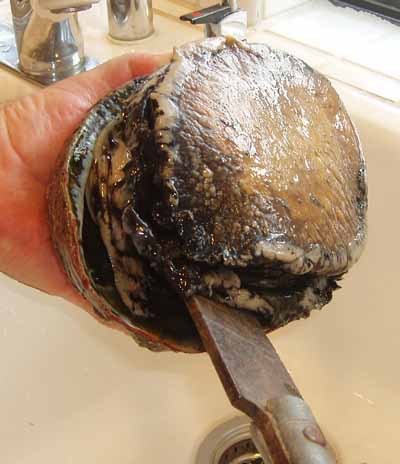
|
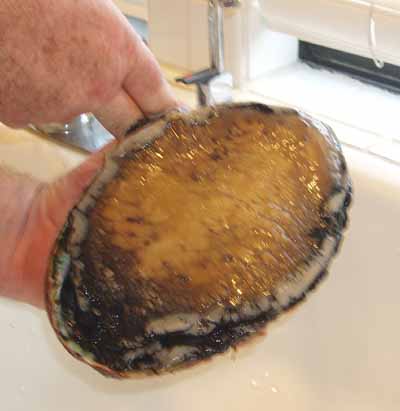
|
The first thing is to get the whole abalone out of the shell.
Hold the abalone with the shell down and the flattest side towards you.
That will make the side of the shell with the rim on your left and the flat side of the shell on your right. Slide the abalone iron under the foot on the flat side of the shell. Try to scrape the top of the foot loose from the shell where it attaches. You should not have to cut it, but I have had to bang the handle end of the ab iron on the ground to force it in. |
The guts are still attached under the rim. Slide your fingers
from the front to the back along the rim to release the
guts. |
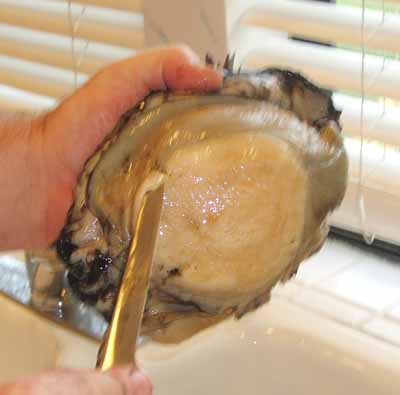 |
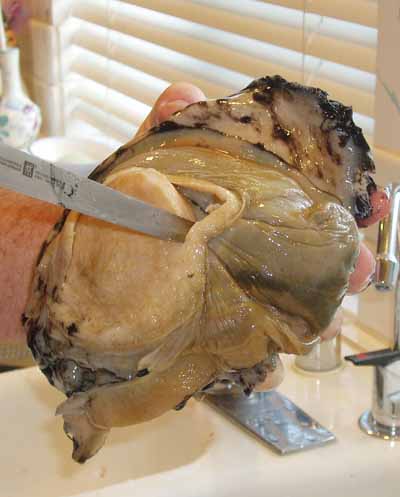 |
Next you want to cut the guts off in one piece. They can be messy so it is good to have something for them to fall in that can be thrown away without having to move them. You want to start at the back and cut towards the head.
|
Start on the right side with the base of the foot down and the
head towards you. You want to cut all the way around the top of
the foot (that was attached to the shell) You generally want to
avoid cutting open the gut because it is full of half digested
kelp and other juicy stuff. If you cut about 1/4 inch almost all the way around into the meat at the top of the foot, the gut should cut away clean. |
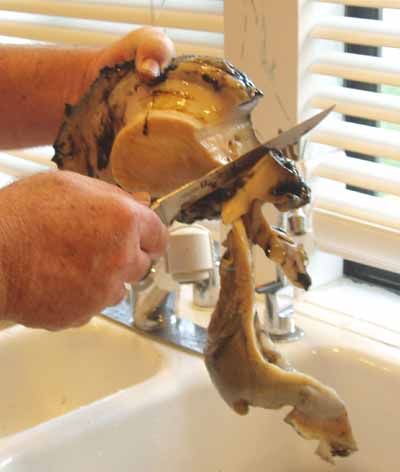 |
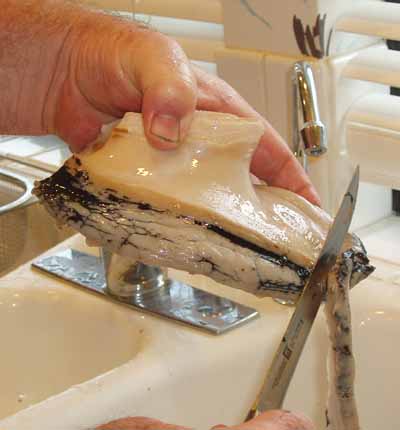 |
When you get to where the guts go into the head, you cut a notch into the meat to remove the head and gut together. This should drop into something for disposal.
Note that in the gut can occasionally be found rare and valuable abalone pearls. You may be able to find these by squeezing the gut to feel for them with your fingers or can actually open it up and spread it around to look for them.
|
The next part is to cut off the sides of the foot. There is a mantle above the foot that can be removed with a single cut along both sides, front to back.
. |
Now cut off a thin layer across the top of the knob where the foot attached to the shell. Make thin cuts to remove the skin around the knob.
|
Cut around the foot on both sides. A little comes off above the foot, a bit more at the bottom. |
Then it takes at least two cuts to go around the base of the foot You don't want to cut deep and waste meat, but from the top of the mantle to the base of the foot, you're going to have to remove at least an 1/8 inch layer so you may as well not make too timid of a cut. You can see when you have cut deep enough to remove the darker thick skin along the side.
|
Nice looking shell. Rince it off and put it out to dry. For how to clean it up nice, see HERE. |
Cut thin slices to remove all the rest of the skin that is left. There should be no skin left on it.
|
The first cut on the foot should be almost 1/4 inch across where the head is. It is dark, hard meat, so you want to remove just a bit more there than most places.
|
The last part is to remove the layer off the bottom of the foot
where the abalone attaches to the rocks.
Mostly this can be removed as a fairly thin layer, though it is
thicker right near the head. The meat at the foot is the darkest and the toughest, but don't cut deep as it may also be the tastiest and if cooked right it is as tender as the rest.
|
Make a slice around the rim on both sides. |
Do whatever it takes to remove a thin even layer from the whole bottom.
|
Don't cut too deep, but get it all off. |
At this point every surface of the meat should have been trimmed. rinse everything very clean including the knife. All those trimmings can be cut up and saved for bait of as something just to feed to the fishes on your next dive.
|
Now it is time to slice. Warning, you need a sharp knife to do this. That along with the fact that abalone is tough to cut means that you had better be very careful or you are going to cut yourself. Do not try this at home or if you are not a professional... whatever that all means. Start by cutting slices to remove the knob.
|
Some people say to cut it thin. I prefer to cut it thicker on the order of 1/4 inch, but have cut it up to 1/2 inch slices. The pounding will make things equal out.
|
With a very large abalone like this, after you are done making the knob into slices, you can cut the main part of the foot in half or thirds. It can make it easier to handle during cooking instead of just having one piece that fills the pan. |
It's easier to handle and cook this way. Now or before is a good time to prepare your oil and spice mix. I'll mention more about that later.
|
There are a variety of devices that can help you cut abalone more evenly and safely. Ask about them in a dive shop near where abalone can be found. |
When you get to the last piece to cut, it can be very difficult to get an even slice, so you may want to set it flat on the cutting board and carefully work your way through it.
|
Now that it is all sliced, you want something good and solid to
set your cutting board on to pound it. Surprisingly, how much you pound it has only so much effect on how tender it turns out. How you cook it is more important.
You want to pound it well, but you don't want to cut it, You want to pound around the outside, because that is the toughest part and the center will get well pounded as you go around It may only take a couple of whacks for a center piece.
|
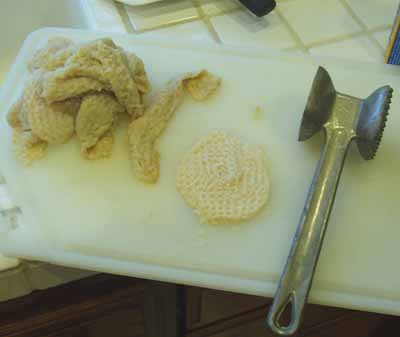 |
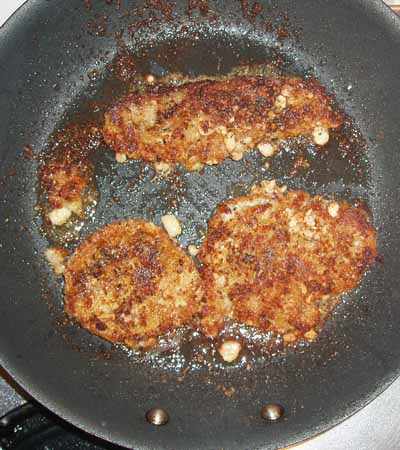 |
As you finish pieces and stack them up, you may want to squeeze a bit of lemon juice on them both for flavor and to keep them from gluing together.
The bottom pieces on the other hand, maybe like the sole of a shoe. Start them with the bottom toughest part up and beat them silly. Then turn them over and finish by pounding the softer part.
|
Now that they are all pounded, it is time for cooking. You should prepare everything for cooking well ahead of time. The key to cooking abalone is cook them fast and hot, otherwise they will be tough.
That looks about right. |
|
.
Make a scrambled egg mix that is about half egg and half milk. Put all the abalone in this bowl, piece by piece so that they are separated and don't glom together. For the recipe here, have about 2 cups of chopped or crushed macadamia nuts. Don't make them too fine. Roasted almonds work well too and are not so rich. Have seasoned bread crumbs on hand.
.
Sometime well before you pound the abalone, you should heat in a pan 1/2 cube of butter and some combination of olive oil, sesame oil, chili oil or whatever you think your heart and tastes can take. In this should be crushed garlic and crushed Italian spices, particularly oregano. Let this heat long enough for the spices to settle into the oils. All of the abalone gets breaded before any gets cooked so that you can keep tossing it into the hot pan without breaks. A little help here can be nice. Put a layer of bread crumbs on a plate. Then put a layer of nuts so that the abalone will pick up mostly nuts. Put the abalone from the eggs onto the plate. Sprinkle more nuts on that side and then some bread crumbs. Pat it all on so it stays. Move these to another plate. Do this until all the abalone is breaded. You should clean up as you go along, as this is one messy meal to prepare. Put a large pan on the stove and turn it hot. I actually like to cook it on the side burner of my bar-b-que so I don't worry about smoke or flames. Heat is the key. Done properly, it may take about 30 seconds per side and if you go for one minute, it is very likely to be getting tough again. Heat the pan. Before you put in pieces, spoon some of the oil and spice mix onto the pieces you are going to put in. When the pan is hot, before the first pieces are put in, put in some butter or oil. When it is really hot, throw in some abalone, spiced side down. Spoon in some oil and spice mix on the top side and squeeze on a bit of lemon juice.
.
Flip it fast, wait until the other side is brown and pile it onto another plate.
.
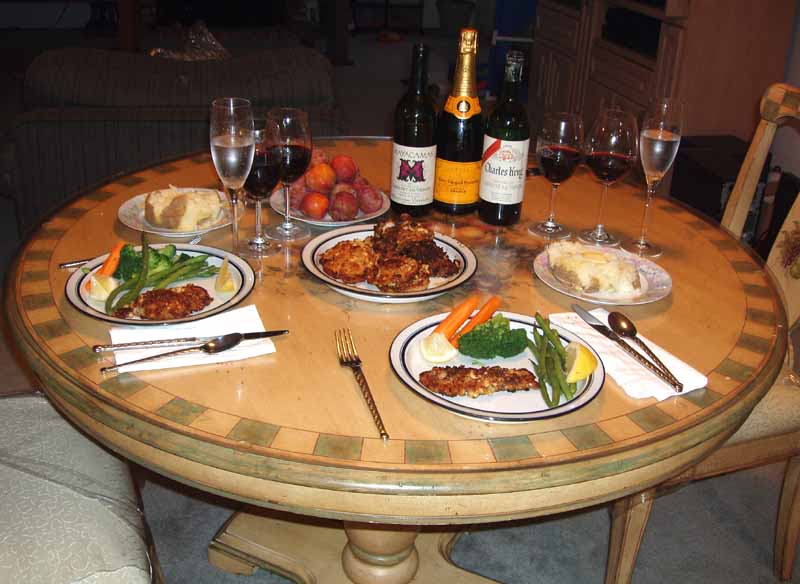
.
It is good served with a fresh vegetable. John, my co-conspirator in culinary creations (and camera man) had already primed our palates with a crab soup. He now prepared a table suitable to the main dish. The 1970 Charles Krug was exquisite and certainly at its prime. The 1972 Mayacamus was pristine with very concentrated flavors. Both were an excellent accent for the meal.
.
The abalone could be cut with a fork. The taste is exquisite.
.
As I always say, enjoy the meal, seahunt
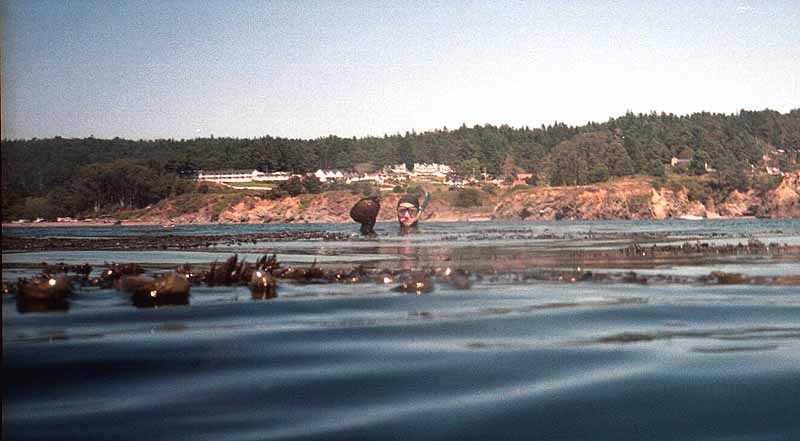
.
To The Recipe Page
| |
|

